EDITOR’S NOTE: Traveleater Lyn shares with us fifteen traditional dishes to try on your next visit to the UAE (United Arab Emirates).
Clouds of fragrant smoke billow out of a shisha as your heart beats to the sinuous rhythm of the darbuka. Accompanied by the strumming of the oud and the glittering tinkle of the Qanun harp, the violin wails, underscored by the rich and yearning tone of the ney cane flute. You sit still, enthralled by the scents and sounds and the rich history they encapsulate and convey.
It’s the perfect setting to enjoy a traditional Middle Eastern meal. The sand dunes of the UAE (United Arab Emirates) would make the perfect setting for such a meal, but you don’t need to go to the desert for this experience.
The Dubai Food Festival celebrates the city’s position as the gastronomic capital of the Middle East. Inaugurated in 2014, this annual food extravaganza offers a plethora of tasty Dubai dishes served side by side with foods from the many nationalities and cultures that call Dubai their home.
The Dubai Food Festival takes place in May but there’s lots of delicious food to be had at any time of the year. Luxury shopping centers abound in the UAE and Dubai Mall and Yas Mall in Abu Dhabi – the biggest shopping centers in their respective cities and among the largest in the world – are like oases for Middle Eastern and Arabic restaurants serving a mouthwatering array of traditional Emirati dishes.
But of course, you can still visit the desert for the ambiance. After all, a desert food safari from Dubai or Abu Dhabi would make for a pretty remarkable experience.
Whichever your preference, here are fifteen traditional Emirati dishes to look for on your next trip to the Middle East, whether it be Dubai, Abu Dhabi, or anywhere else in the UAE.
EMIRATI CUISINE QUICK LINKS
If you’re planning a trip to the United Arab Emirates (UAE) and want to learn more about Emirati cuisine, then you may be interested in joining a food tour.
TOURS & OTHER SERVICES
- Dubai: Food Tours in Dubai
- Abu Dhabi: Food Tours in Abu Dhabi
- UAE eSIM
Save This on Pinterest!
No time to read this guide on traditional Emirati food? Click on the save button and pin it for later!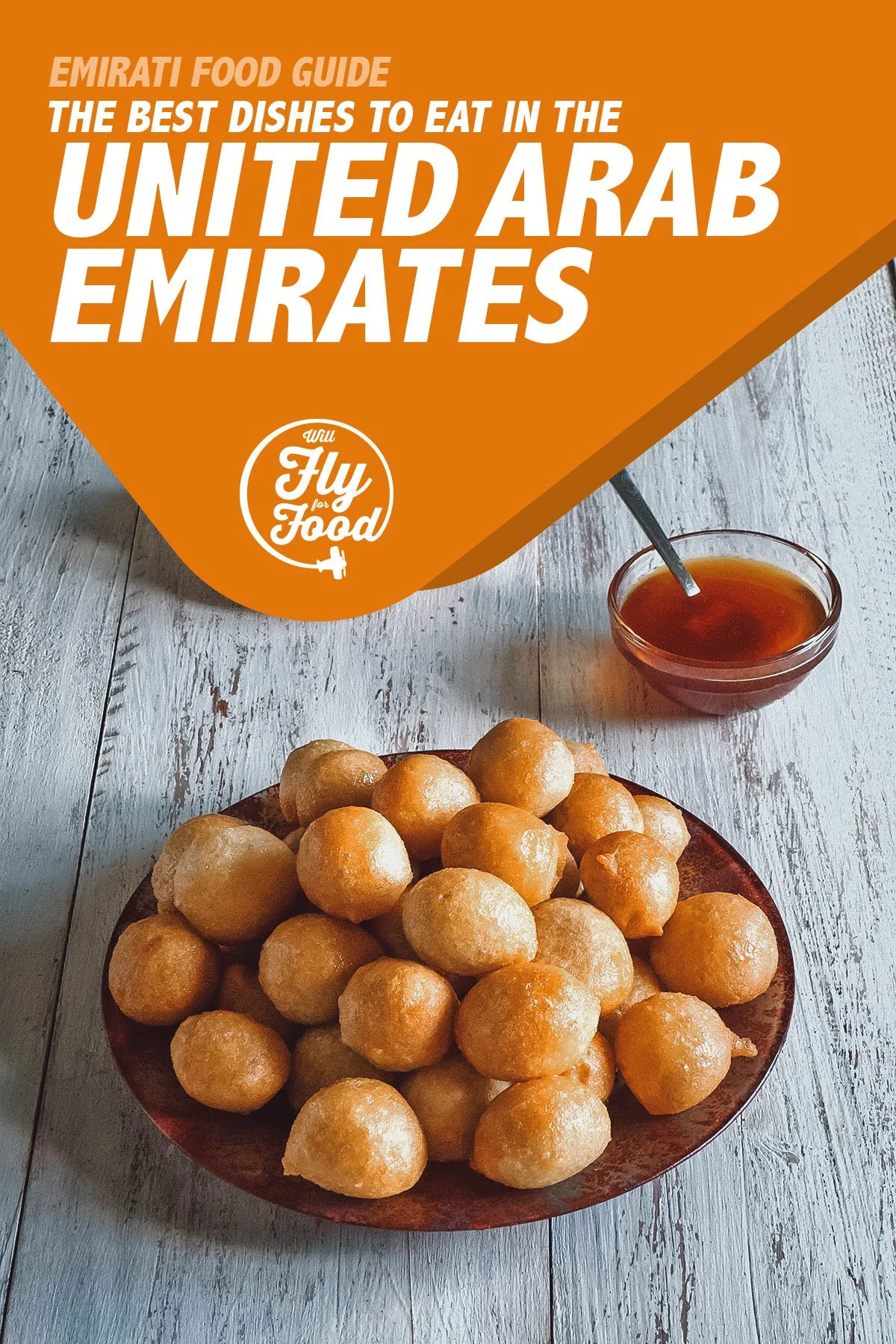
Photo by sablinstanislav
WHAT IS TRADITIONAL EMIRATI CUISINE?
Emirati cuisine refers to the Arabic food traditions of the United Arab Emirates. It consists of aromatic dishes flavored by a wealth of spices and herbs like saffron, turmeric, cinnamon, cardamom, coriander, and thyme.
Meat, grain, and dairy are used extensively in traditional food. Dates, roasted nuts, and dried limes called loomi are key ingredients in many Emirati recipes. Being a desert nation, vegetables aren’t featured as strongly in the local cuisine.
Chicken, small fowl, goat, and lamb are the most commonly consumed meats in the UAE. Being a country on the Persian Gulf, fish and seafood feature prominently in the Emirati diet as well. Camel meat is also consumed though it’s typically reserved for special occasions.
Many traditional Emirati dishes come in the form of stews prepared in single pots. This can be traced back to the country’s desert landscape where having fewer dishes to wash was key.
Being a multicultural nation and one of the top tourist destinations in the world, the food in Dubai and Abu Dhabi is becoming increasingly international. But as this list will show you, there are plenty of traditional Emirati dishes to look forward to in the UAE.
MUST-TRY FOOD IN DUBAI & ABU DHABI
1. Khobz Al Khameer
Khobz al khameer is a traditional Emirati yeasted flatbread typically served as a breakfast dish. It’s a golden-hued bread cooked with ghee or egg wash and topped with sesame seeds. It’s made with ingredients similar to yeast bread served in other parts of the world.
In addition to the usual yeast bread ingredients, khobz al khameer is often made with a pinch or two of spice. Cardamom and turmeric are favorites while saffron is used mainly as a coloring agent. Khboz al khameer is also made using milk powder instead of liquid milk which is more common in the west.
Khobz al khameer is an airy and hollow bread that’s cooked on a special khameer bread maker or oven. The bread is first cooked on the oven’s cover for a minute before being transferred inside where it quickly rises and puffs up.
When cooked, the bread’s hollow center can be filled with date paste or any other filling. It can also be served with date syrup and cheese.
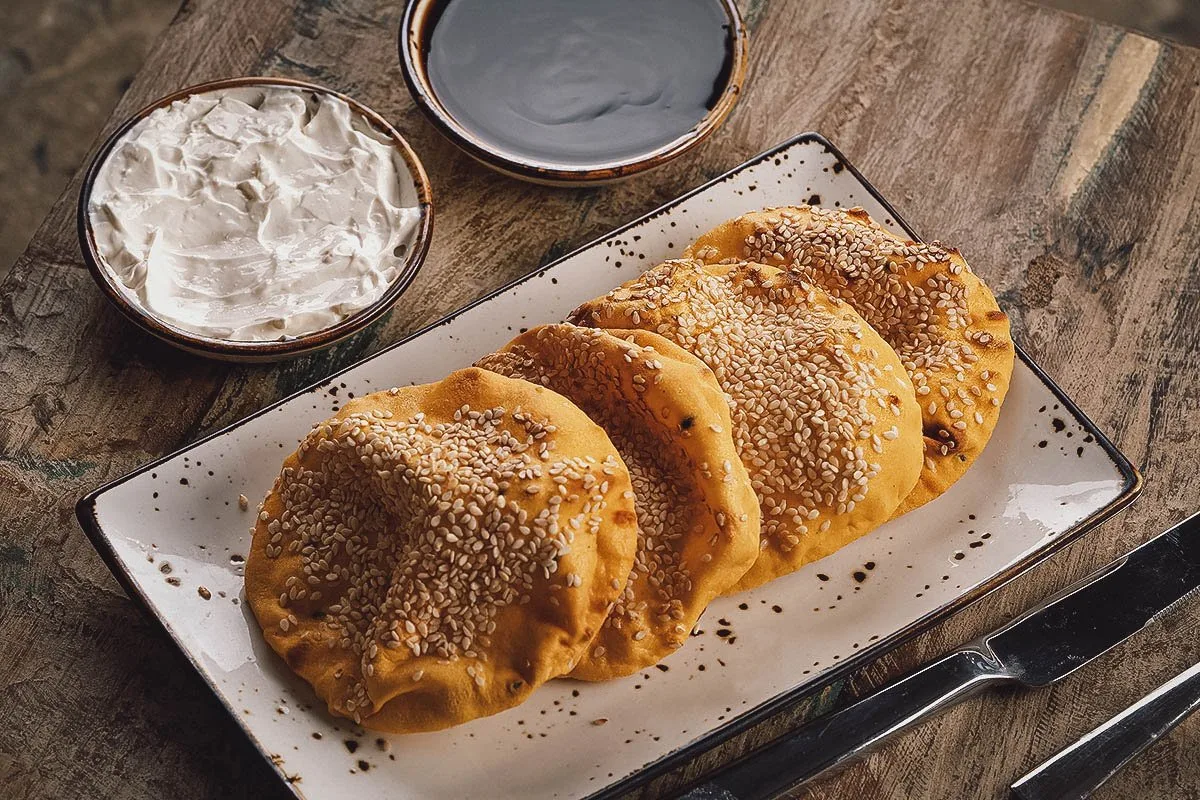
Photo by Wirestock
2. Rigag
Rigag is an unleavened, wafer-thin traditional Emirati flatbread that you can enjoy on its own, typically for breakfast, or as an accompaniment to stews like tharid. Made with just three ingredients – flour, water, and salt – it becomes especially popular during the holy month of Ramadan.
When enjoyed as a standalone dish, rigag is often topped with cheese, eggs, honey, and other ingredients while still cooking on a pan. When eaten as an accompaniment, it can be served topped or incorporated into meat stews, or served on its own with a side of yogurt.
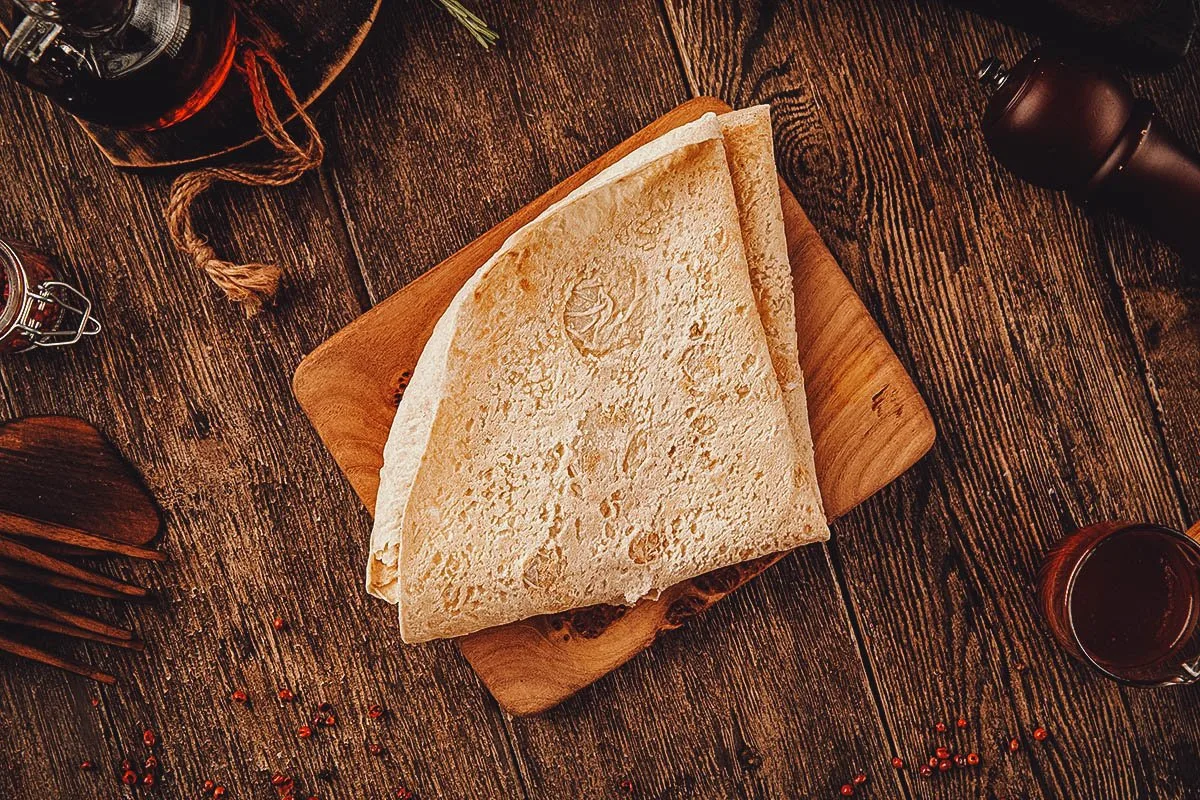
Photo by Hihitetlin
3. Chebab
You can think of the chebab as a type of yeasted Emirati pancake. They’re similar to Moroccan baghrir except they’re more flavorful and aromatic thanks to the use of spices like cardamom and saffron.
A popular breakfast dish, these delicious spiced pancakes are usually served with cheese and date syrup.
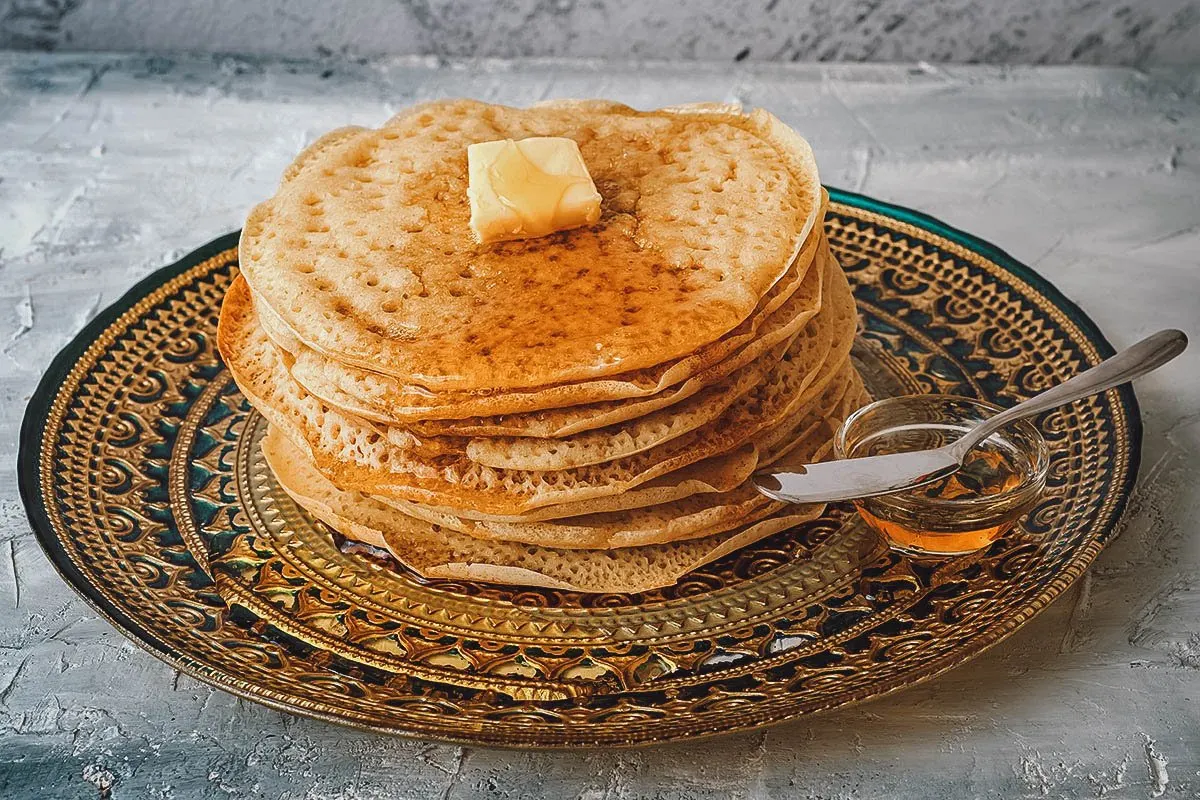
Photo by [email protected]
4. Balaleet
Balaleet is another popular breakfast dish in the Emiartes. It refers to a noodle dish that can be both savory and sweet. It is, in fact, a savory-sweet dish that’s typically served for breakfast though it can also be eaten for dessert.
Balaleet is made by first sauteeing and then boiling vermicelli noodles. Once they’re cooked, they’re sweetened with sugar, cardamom, turmeric, and saffron-infused rose water. When eaten for breakfast, they’re usually served with an omelette or scrambled eggs on top.
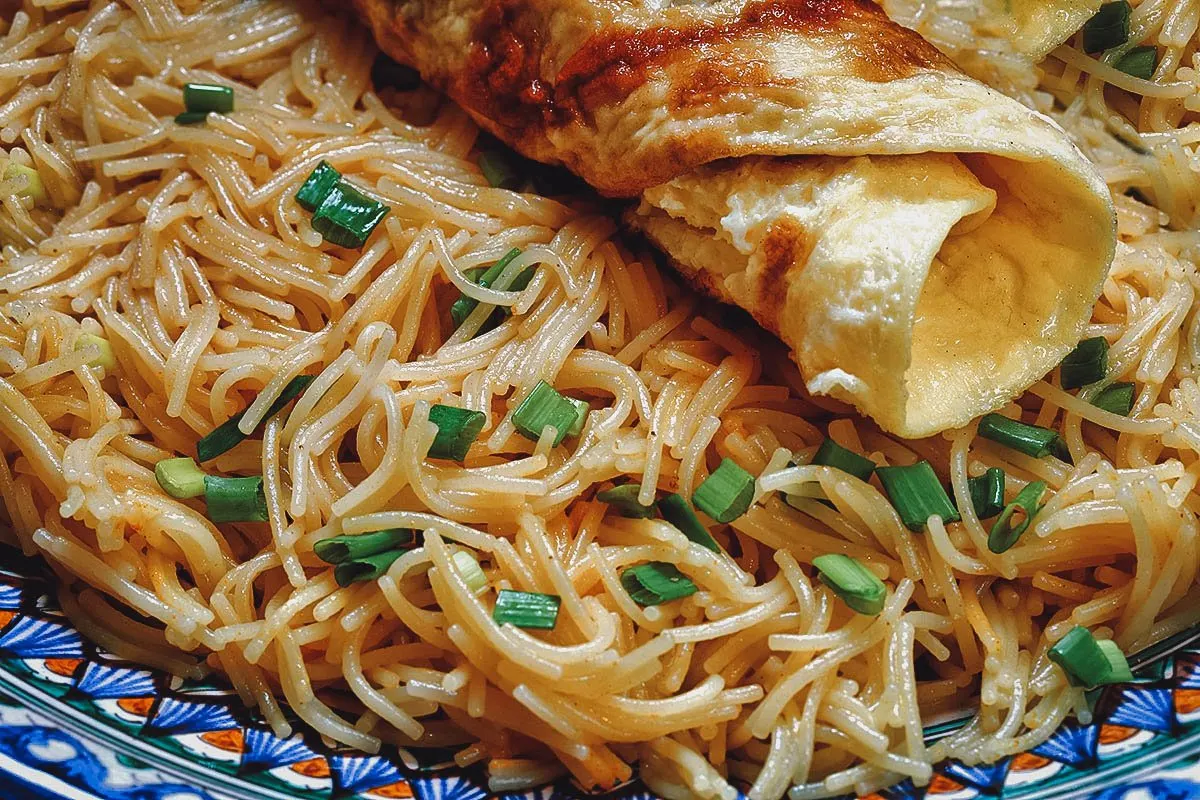
Photo by DmZo
5. Shakshuka
Shakshuka is believed to be Tunisian in origin though it’s a staple breakfast dish in many parts of North Africa and the Middle East, including the UAE. In recent decades, it’s been embraced by the west and has become one of the most popular breakfast dishes hailing from that region of the world.
Shakshuka refers to a simple but delicious tomato-based dish of poached eggs. To make it, shallots, garlic, tomatoes, bell peppers, and chilies are first sauteed in olive oil. Tomato paste, pureed uncooked tomatoes, and honey are then added to the pan.
Once the tomato base is cooked, eggs are cracked into the mixture. The egg whites are allowed to blend into the tomato sauce while the egg yolks are left intact and poached to perfection. The dish is then sprinkled with za’atar and garnished with basil leaves before serving.
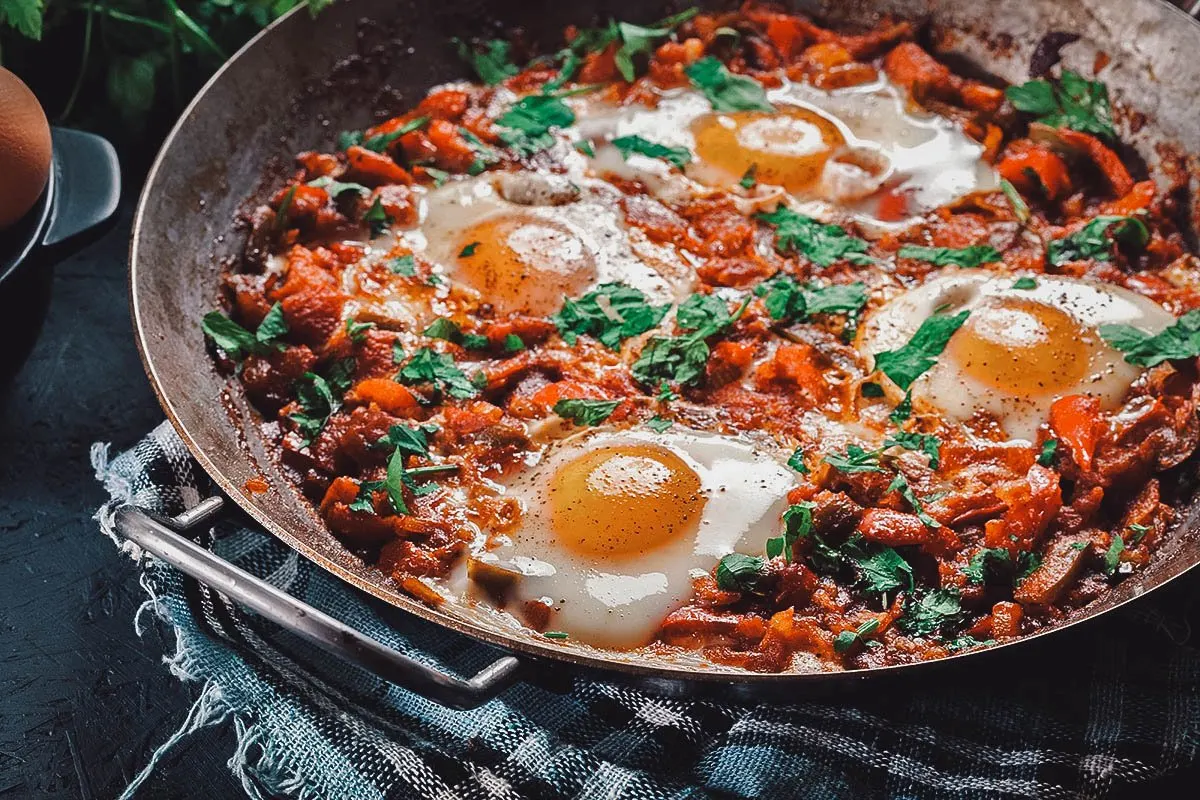
Photo by fotek
6. Harees
Harees is a popular traditional dish in Emirati cuisine. It refers to a porridge made with beaten skinless wheat and meat, usually chicken or lamb. It’s typically served garnished with different ingredients like sugar, cinnamon, ghee, pistachio, and raisins.
Harees becomes especially popular during the holy month of Ramadan. It’s a filling and nutritious dish that’s easy on the stomach, which is a boon during the month of fasting.
Before using, wheat has to be soaked for at least 5 hours, better if overnight. It’s then placed in a pot of water with meat, onion, garlic, and spices. Even with a pressure cooker, it still takes at least 1.5 hours for the wheat to be fully cooked through. The grains are then mashed till smooth and cooked in a pan with the deboned meat and coconut milk while being constantly stirred.
Indeed, the cooking process is long and laborious, but it shouldn’t be difficult to find Emirati restaurants that serve traditional harees, especially during Ramadan. It’s a popular dish throughout the Arabian Peninsula and in other countries like Armenia.
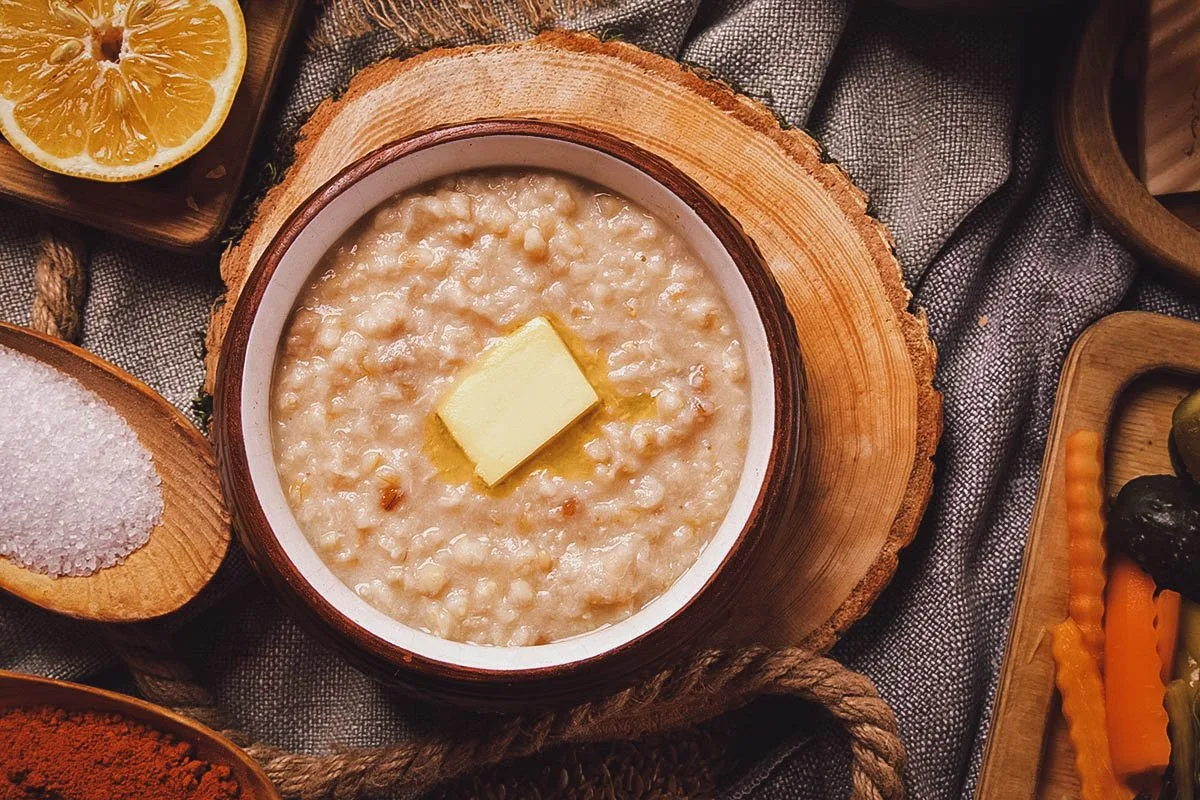
Photo by Wirestock
7. Madrouba
Madrouba, also spelled madrooba, is another type of Emirati porridge made with rice and meat, usually chicken. It’s similar to harees in that it’s traditionally prepared by beating the rice into a smooth mash using a wooden spoon called a medhrab. Though the dish may look deceptively simple, it can be fairly involved to make.
To prepare, the meat is first boiled and simmered in a pot of water with caramelized onions, dried lime, and spices. After the meat is cooked all the way through, rice is added and stirred constantly to ensure that it doesn’t stick and burn.
Stirring also softens the rice instead of leaving it to absorb all the fluids like in machboos. The rice is then mashed into a fine consistency.
For me, madrouba is the ultimate comfort food. It’s thick, nutritious, and filling. Plus it’s delicious, too.
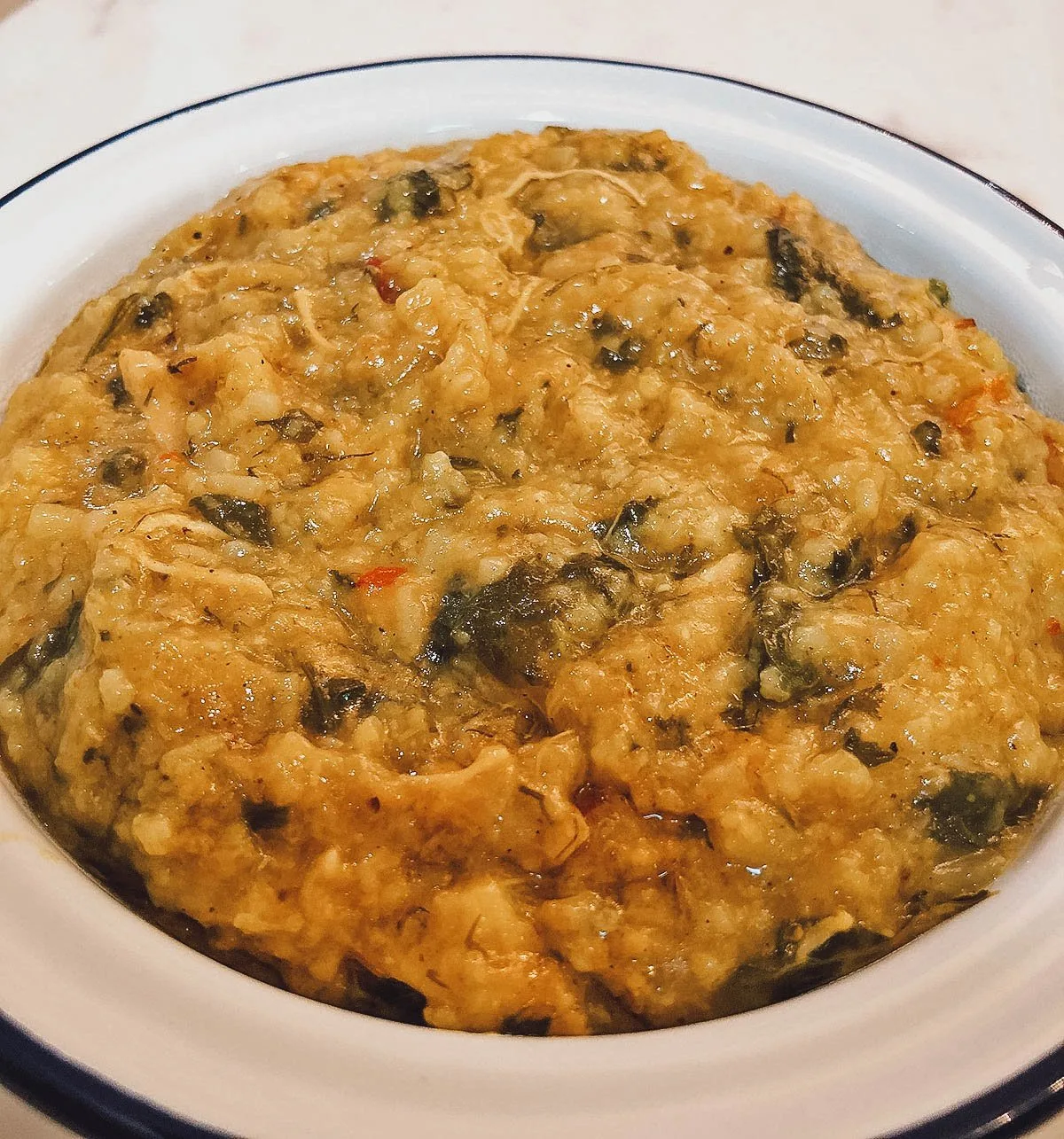
Photo by AmnaMF, CC BY-SA 4.0, via Wikimedia Commons
8. Tharid
Like harees, tharid is a preferred dish for iftar and for breaking the fast during the holy month of Ramadan. Also known as thareed, it refers to a thick stew made with some type of meat like chicken, lamb, or goat mixed with potatoes and seasonal vegetables. The stew is typically served on or with rigag, the traditional Emirati flatbread.
Tharid is a heavily-seasoned, melt-in-your-mouth meat dish, the result of slowly simmering meat and other ingredients in spices for at least 1.5 hours. The flatbread served with the stew soaks up the dish’s juices and serves as a handy vessel for scooping up the meat and vegetables.
Without question, tharid is a heavenly combination of flavors and textures and one of the best Emirati dishes you can try in Dubai and Abu Dhabi.
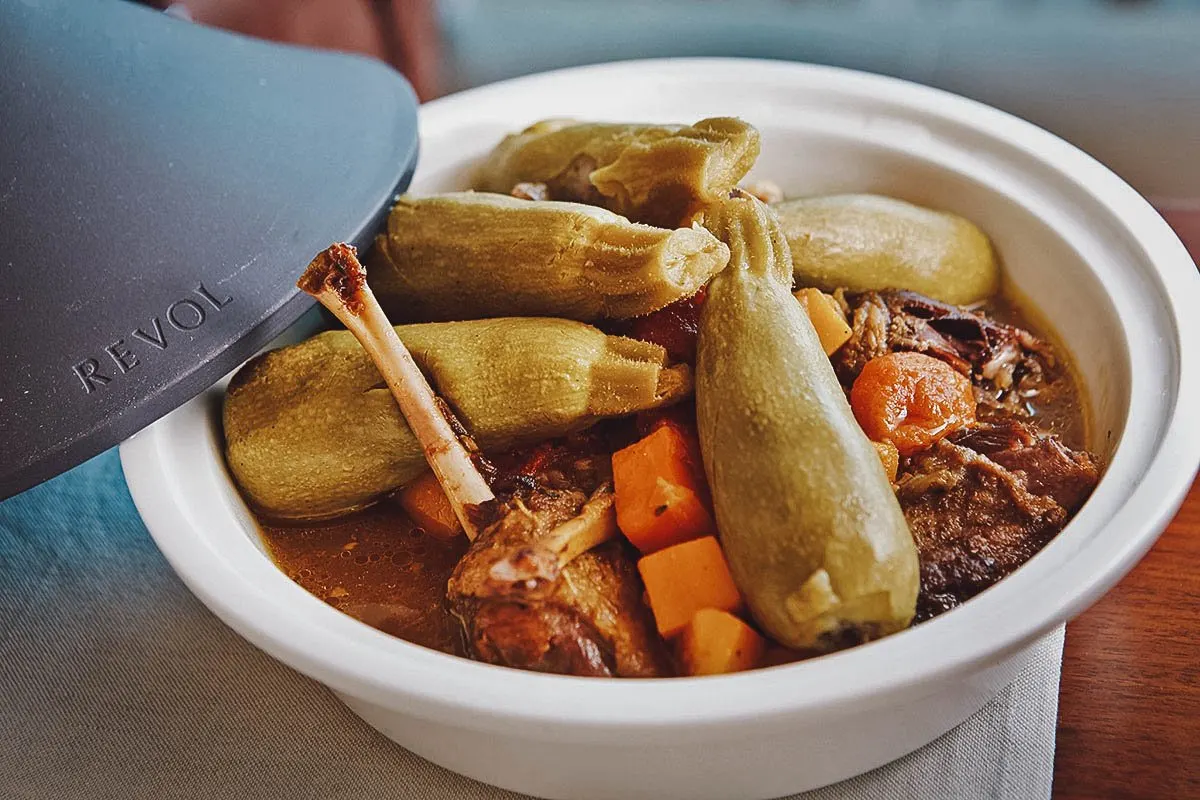
Photo by topphoto
9. Ghuzi
Ghuzi or khuzi is a delicious slow-cooked meat and rice dish. Like machboos, it’s considered by many to be a national dish of the UAE.
Ghuzi recipes vary but one restaurant in Dubai makes it by marinating meat – usually lamb or goat – in spices like garlic, ginger, cardamom, cinnamon, bay leaves, and saffron for at least 8 hours. The marinated meat is then cooked in an oven for 4 hours at low heat until the meat turns a reddish-brown color.
Once the meat is fully cooked and ready to be served, it’s placed on a bed of rice and potatoes. The rice, which has been soaked in water and then slow-cooked in the lamb’s braising liquid, forms the bottom layer. This is then followed by roasted potatoes before being topped with meat.
Before serving, ghuzi is often garnished with currants, raisins, and roasted nuts like pistachios.
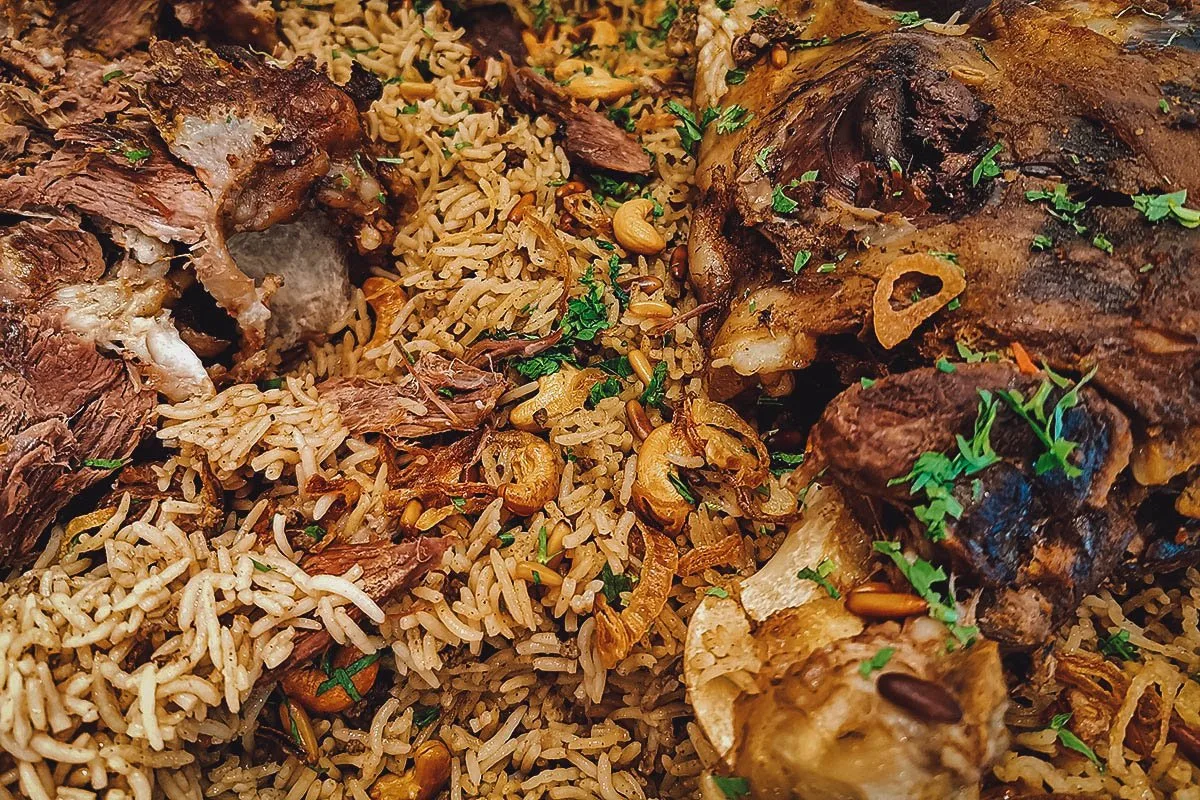
Photo by [email protected]
10. Machboos
No Dubai food guide would ever be complete without machboos. Also known as kabsa, it’s a traditional rice dish that’s widely considered to be a national dish in all countries of the Arabian Peninsula.
Machboos refers to a hearty meat and yellow basmati rice dish. But unlike Ghuzi, the meat and rice are cooked together in one pot.
The meat, usually lamb, is marinated in a mixture of spices like garlic, cumin, cloves, bzar (Emirati spice blend), and chilli powder. It’s then browned in oil before being braised in water or stock with onions, garlic, turmeric powder, coriander powder, dried lime, and chopped tomatoes.
Once the meat is almost cooked, soaked basmati rice is added to the pot and slow-cooked at very low heat, undisturbed, until all the cooking liquid is absorbed. Coriander leaves and green chilies can also be added before the rice is fully cooked.
You can find delicious machboos at many restaurants in Dubai and Abu Dhabi but one of my personal favorites is the highly-rated Al Fanar Restaurant & Café in Yas Mall. If you visit Abu Dhabi, then I highly recommend trying it there.
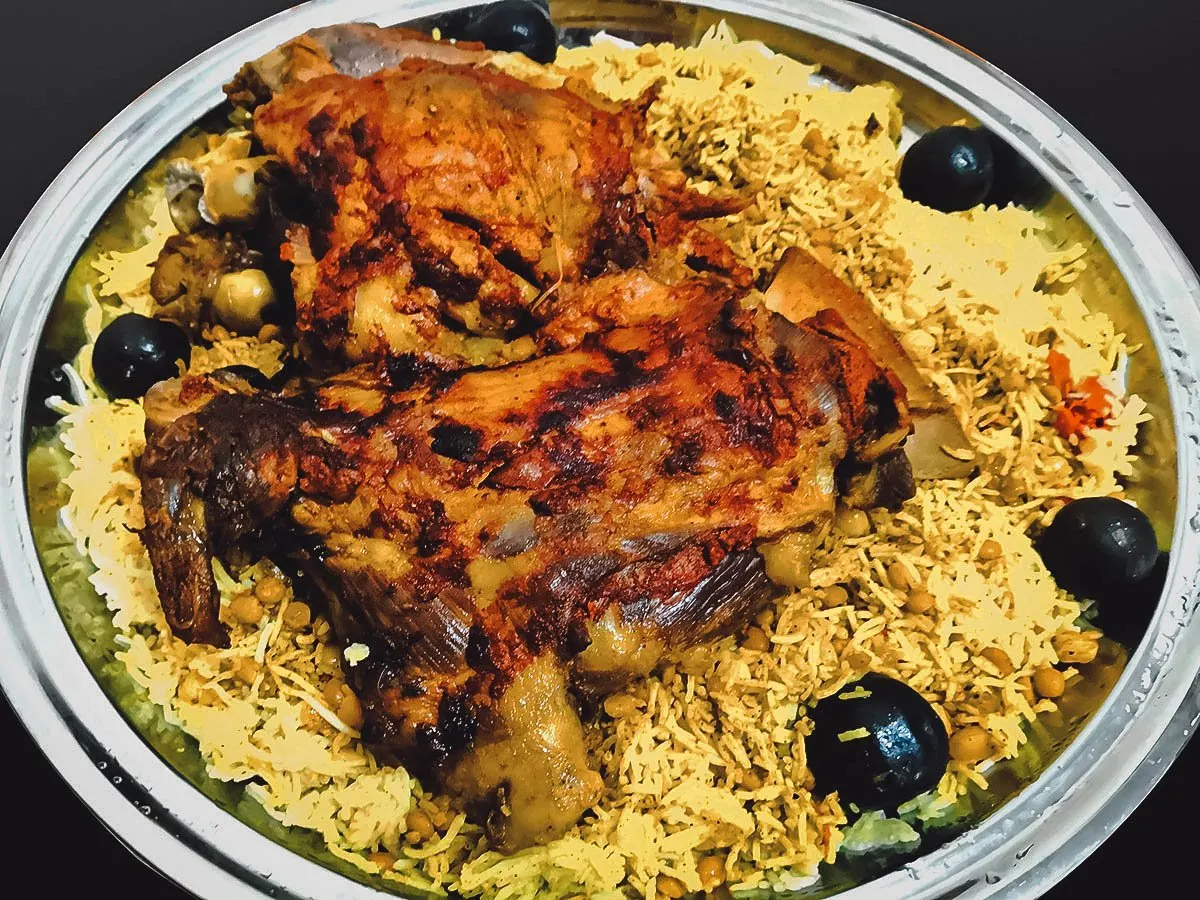
Photo by Senalfred
11. Maqluba
As you can probably tell by now, hearty meat and rice dishes are popular in Emirati cuisine. Maqluba or maqlooba is another example. The word maqluba literally means “upside-down” and refers to the way the pot used to cook the dish is flipped upside down to serve it.
Like ghuzi and machboos, maqluba is made with rice, meat, tubers, and vegetables. Chicken and lamb are the preferred meats while eggplant and cauliflower are the most commonly used vegetables. The different ingredients are layered carefully in the pot with the vegetables going in first, followed by the meat, then the rice.
Maqluba is typically garnished with pine nuts and chopped fresh parsley and served with salad and yogurt.
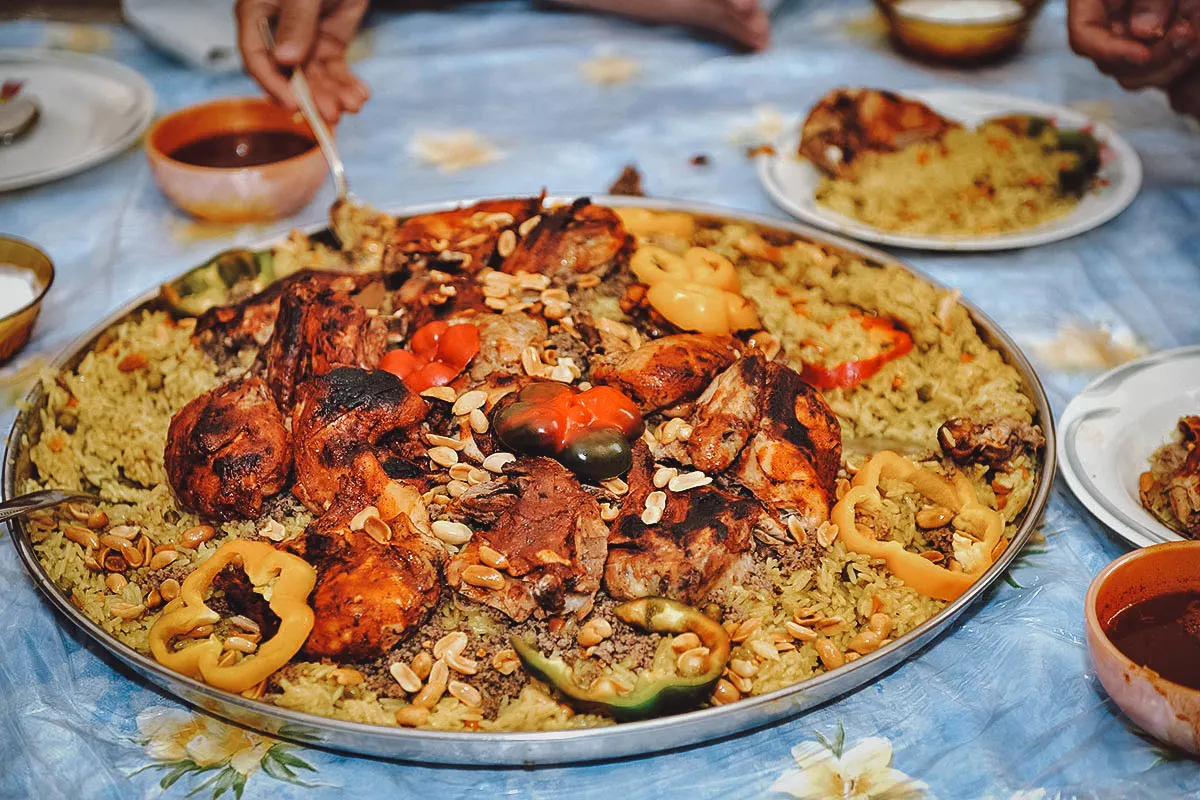
Photo by zurijeta
12. Samak Mashwi
Thanks to its location in the Persian Gulf region, fish and seafood have long featured prominently in traditional Emirati cuisine. There are many delicious seafood dishes you can try in Dubai and Abu Dhabi, one of my favorites being samak mashwi.
Samak mashwi refers to fish, usually seabream, grilled in the traditional Emirati way. The fish is marinated in a mixture of herbs and spices like coriander, cumin, chilli, turmeric, paprika, dried lime powder, and date paste. The fish is then grilled with its scales still on to help it stay moist even in high heat. It’s a delicious dish and a must-try in the UAE.
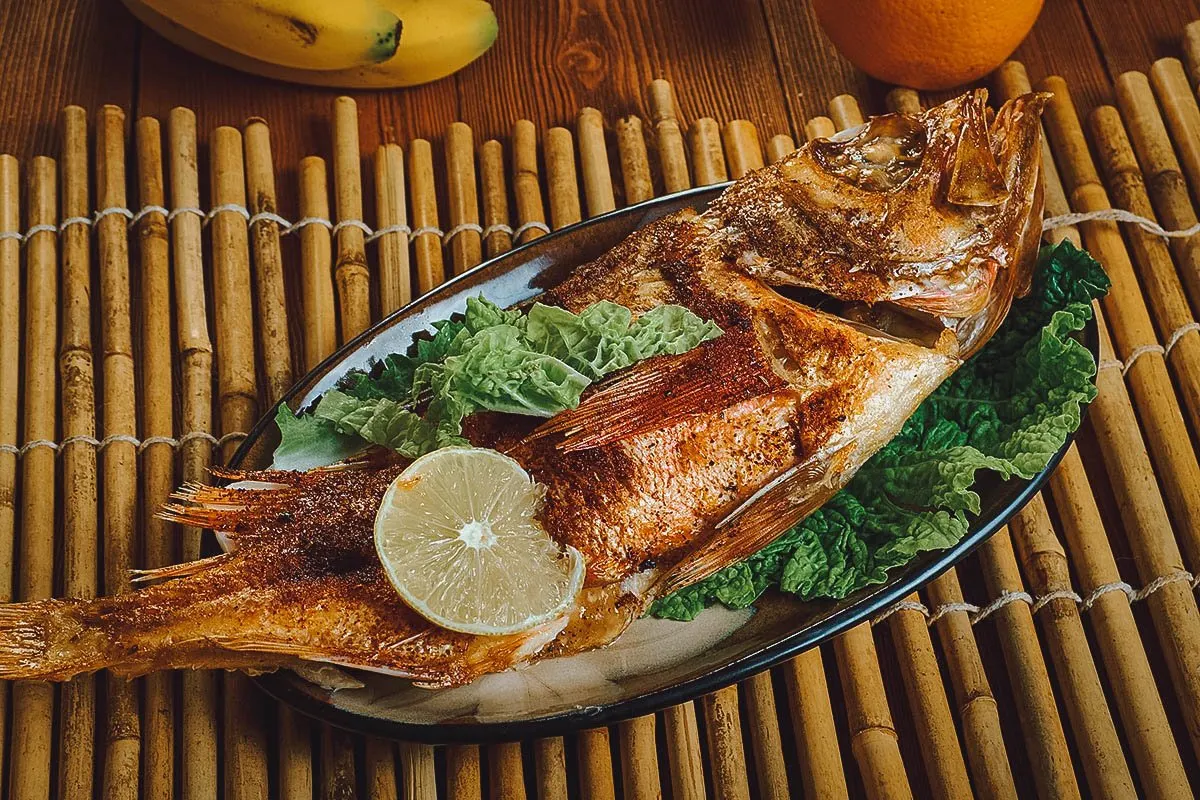
Photo by fanfon
13. Luqaimat
If you’re curious about trying Arabic desserts, then you can start with luqaimat. Sweet, sticky, and crunchy, they’re a popular street food in Dubai and Abu Dhabi and a beloved traditional Emirati dessert.
Luqaimat are essentially deep-fried dough balls flavored with spices like cardamom and saffron. They taste like crispy fried doughnuts – crunchy on the outside and soft and fluffy on the inside.
Luqaimat are typically glazed or drizzled with date molasses before being garnished with sesame seeds for added texture. Because they’re so sticky, they’re typically eaten using toothpicks or mini-skewers.
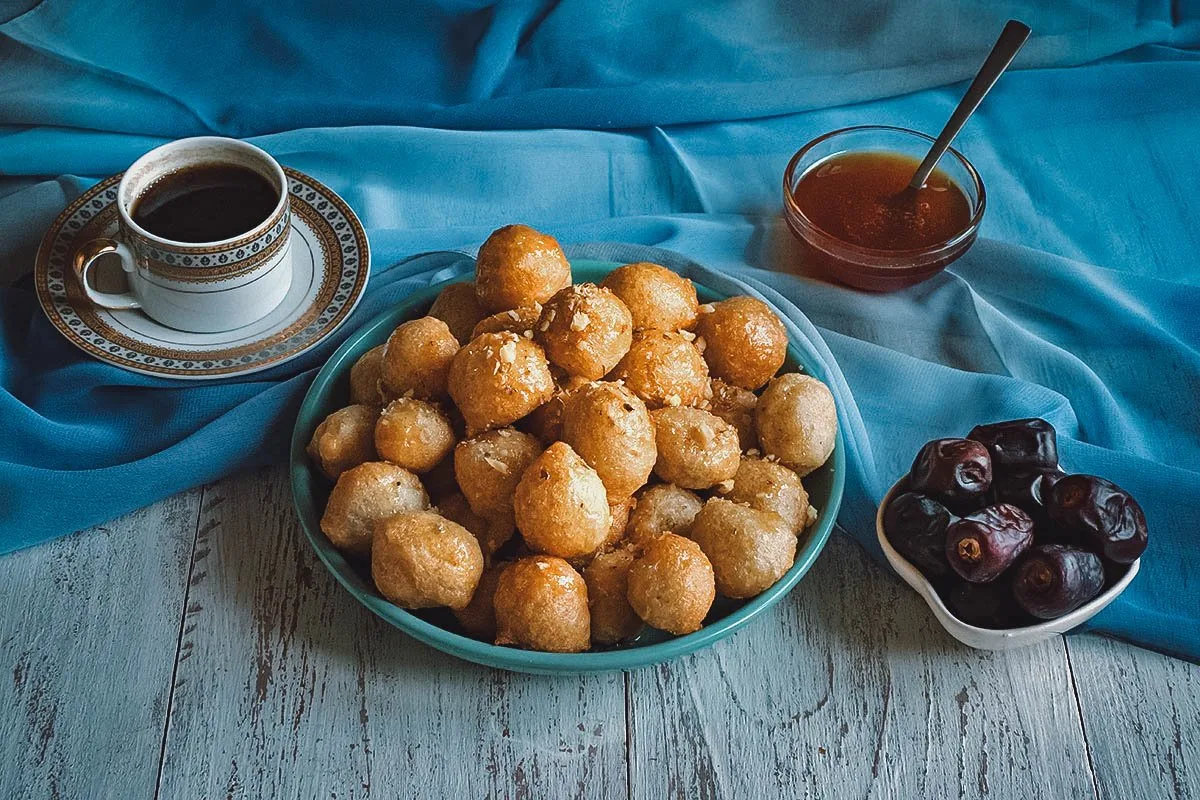
Photo by sablinstanislav
14. Kunafa
If you visit Dubai or Abu Dhabi, then you must not miss kunafa. It’s an incredibly delicious dessert that’s consumed in many Arab and Balkan countries like Egypt, Turkey, Greece, and Lebanon.
Kunafa consists of kataifi pastry soaked in a sweet, sugar-based syrup and layered with cheese. Depending on where it’s from and who’s making it, it can be enriched with other ingredients like pistachios, almonds, raisins, rose water, lemon juice, and cinnamon. It’s decadent and delicious and a definite must-try dessert in the UAE.
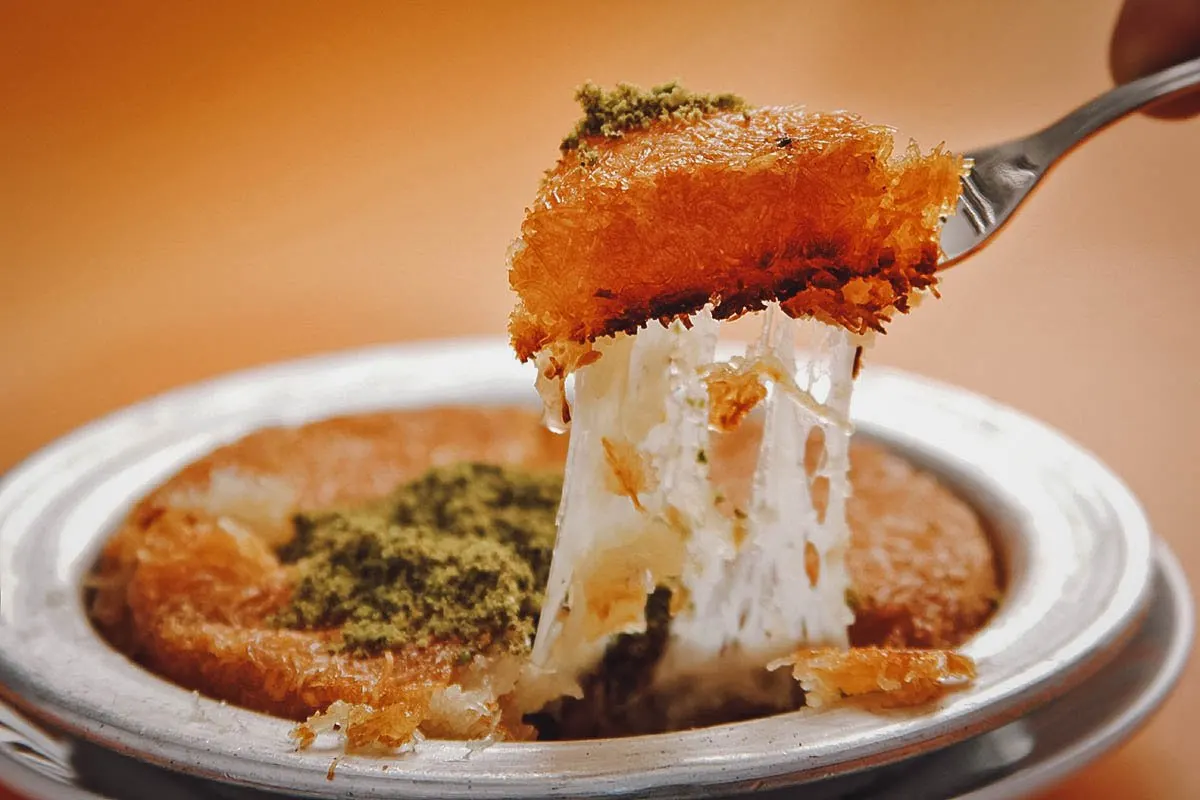
Photo by reflex_safak
15. Gahwa (Arabic Coffee)
There’s no better end to a decadent meal in Dubai than with dessert and a cup of Arabic coffee. Known in the Emirati dialect as gahwa, coffee has been a central part of Arab culture for centuries. In fact, so important is the coffee tradition to Arab culture that it was awarded Intangible Cultural Heritage status by UNESCO in 2015.
The preparation and consumption of Arabic coffee is steeped in ritual. It’s a national tradition in the UAE and considered a symbol of unity and generosity.
Arabic coffee is strong and bitter so it’s traditionally served with dates and other desserts.
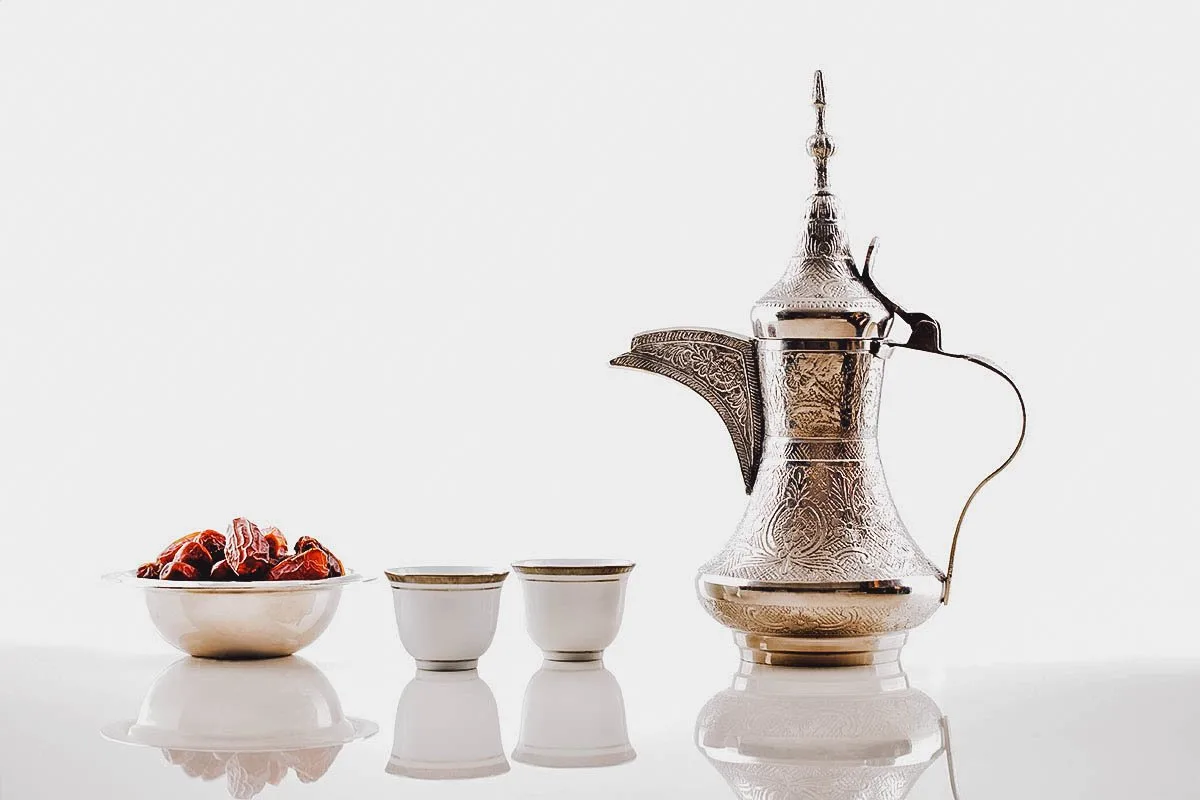
Photo by Sophie_James
BONUS: Stuffed Camel
This last entry is an interesting but uncommon dish so I thought I’d add it as a bonus.
If you want a memorable, truly out-of-this-world experience in Dubai, then you need to try stuffed camel. It’s a lavish and extravagant dish that takes a whole village (or what might feel like it) to prepare.
Stuffed is the operative term. The camel is cleaned, trimmed, and then stuffed with an entire cooked lamb. The lamb itself is stuffed with whole cooked chickens, which are in turn stuffed with cooked rice and boiled eggs. After the camel has been sufficiently stuffed, it’s roasted on a spit over an open flame until cooked through.
As delicious as it sounds, you might have difficulty finding this stuffed camel dish at regular Emirati restaurants. Stuffed camel is traditional Emirati wedding fare so if you’re lucky enough to be invited to a traditional upscale UAE wedding, then you might find it there.
EMIRATI FOOD TOURS
Needless to say, no one knows traditional food in the Emirates better than someone who actually lives there. So what better way to experience the food in Dubai and Abu Dhabi than with a local guide? Not only can they take you to the city’s best markets, street food stalls, and restaurants, but they’ll be able to explain all the Emirati dishes to you in more detail.
Check out Get Your Guide for a list of food-related tours and activities in Dubai and Abu Dhabi.
FINAL THOUGHTS ON TRADITIONAL EMIRATI CUISINE
To a lot of people, Emirati food is shrouded in mystery. However, it’s one cuisine that needs to be discovered.
Traditional Emirati cuisine is exciting, intense, unique, and most certainly worth exploring. If you visit Dubai in May, then you need to attend the Dubai Food Festival. Add it to your itinerary along with traditional Emirati restaurants in Dubai, Abu Dhabi, and any other destination in the UAE.
There are many reasons why Dubai and Abu Dhabi are among the most visited cities in the world. Good local food is definitely one of them.
Disclosure
Some of the links in this article on traditional Dubai foods are affiliate links. If you make a booking or reservation, then we’ll earn a small commission at no added cost to you. As always, we only recommend products and services that we use ourselves and firmly believe in. We really appreciate your support as it helps us make more of these free travel and food guides. Thank you!
Cover photo by sablinstanislav. Stock images via Depositphotos.


Saman kadahettige
Thursday 6th of October 2022
Thanks for the very helpful tips about Emirates cuisine.